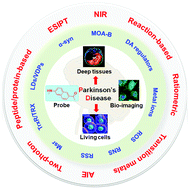Fluorescent probes for bioimaging of potential biomarkers in Parkinson's disease
Abstract
Parkinson's disease (PD), as the second most common neurodegenerative disease, is caused by complex pathological processes and currently remains very difficult to treat. PD brings great distress to patients and imposes a heavy economic burden on society. The number of PD patients is growing as the aging population increases worldwide. Therefore, it is crucial to develop new tools for aiding the early diagnosis and treatment of PD. The significant pathological features involved in PD include the abnormal accumulation of α-synuclein, metal ion dyshomeostasis, oxidative stress, mitochondrial dysfunction and neurotransmitter deficiencies. In recent years, fluorescent probes have emerged as a powerful bioimaging tool with potential to help understand the pathological processes of PD via the detection and monitoring of pathological features. In this review, we comprehensively summarize the design and working mechanisms of fluorescent probes along with their applications in the detection of various PD biomarkers. We also discuss the current limitations of fluorescent probes and provide perspectives on how these limitations can be overcome to develop better fluorescent probes suitable for application in clinical trials in the future. We hope that this review provides valuable information and guidance for the development of new fluorescent probes that can be used clinically in the early diagnosis of PD and contributes to the development of efficient PD drugs in the future.



 Please wait while we load your content...
Please wait while we load your content...